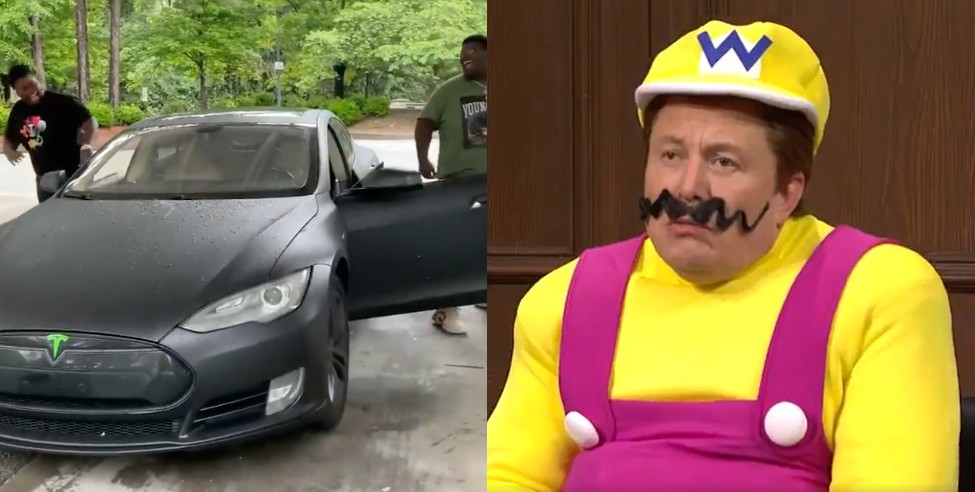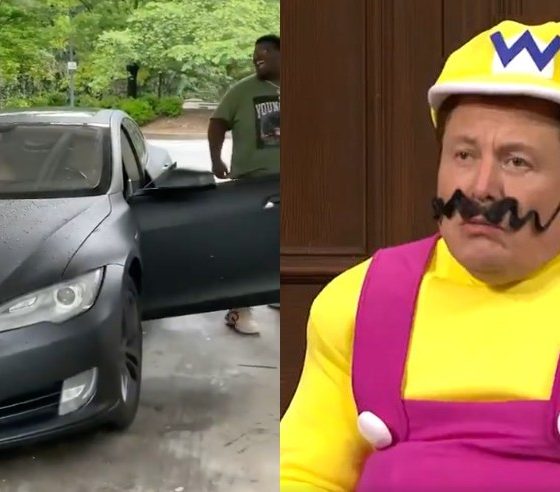

News
EV fans are using Tesla memes to win over skeptics during recent gas crisis
With memes being the preferred language of the internet and with the United States East Coast recently experiencing a gas crisis, it was almost inevitable to see EV fans using Tesla memes and jokes to make a point and perhaps even win over some fossil fuel supporters. Over the past few days, and as the lines of cars in gas stations got longer, memes about “Tesla owners during a gas crisis” became more widespread and creative.
The thesis of the Tesla memes was straightforward. Gas cars need fossil fuels to run, so when the supply of gas is compromised, said vehicles could not run. This results in panic buying for some car owners. Over the past days, images of people siphoning gas off one car into another, as well as people storing fuel in plastic bags, inspired lots of raised eyebrows and laughs among netizens.
@tesla owners gloat over the pipeline gas crisis @StephenAtHome pic.twitter.com/alTxRS3RKa
— Talking Tesla (@talkingtesla) May 14, 2021
Tesla owners simply do not have such problems. Thanks to their vehicles being powered by electricity, Tesla owners could simply charge their cars from their homes, just like their smartphones. Owners who have solar panels installed in their houses are even better off since not only can they run their cars, they can do so using literal sunlight. Needless to say, these EV advantages became an excellent source for memes online.
https://twitter.com/ThisIsMemeboi/status/1392944109040590856?s=20
Apart from memes, short, funny videos highlighting Tesla owners during the ongoing crisis also made the rounds online. A couple of friends in a Model S who visited a gas station convenience store during the gas shortage proved immensely popular with over 115,000 likes on Twitter. Even the hosts of the Holderness Family Vlogs channel on YouTube got involved (albeit inadvertently) by sharing a skit of how Tesla owners are, particularly at a time when gas is scarce.
I just KNOW Tesla owners feeling like this right now pic.twitter.com/TRX8R0l9UU
— JamariJonesATL (@JamariJones_ATL) May 12, 2021
In the case of the YouTuber, the intended jokes about Tesla owners became all too real and ironic, as the host of the channel revealed that his personal vehicle, a gas car, was actually in need of some fuel. But with the fuel crisis ongoing, it was tough to get some gas. With that in mind, the host noted that he should probably just keep borrowing a friend’s Tesla, which could operate without any issues despite the fuel shortage.
Everyone with a @Tesla during the current gas crisis. 😄 pic.twitter.com/Pux066H4uV
— Emory Serviss, PhD (@eserviss) May 12, 2021
Memes and funny videos may be used mostly for harmless fun, but there is no denying that they do work. Tesla CEO Elon Musk knows this, and this is one of the reasons why he himself dabbles in a lot of memes and humor. A look at the comments and threads of posts on Twitter about EVs operating fine in the fuel crisis also shows conversations and debates about the benefits of electric cars, hinting that a growing population is becoming more aware of EVs and their advantages. Ultimately, within the brought photos and the loud videos of the past few days, a notable narrative was being pushed—Tesla owners feel great during a gas shortage, and if you get an EV, you can feel the same way too.
Watch the Holderness Family’s video about Tesla owners in a gas shortage in the video below.
Don’t hesitate to contact us for news tips. Just send a message to tips@teslarati.com to give us a heads up.

News
Tesla starts showing how FSD will change lives in Europe
Local officials tested the system on narrow country roads and were impressed by FSD’s smooth, human-like driving, with some calling the service a game-changer for everyday life in areas that are far from urban centers.

Tesla has launched Europe’s first public shuttle service using Full Self-Driving (Supervised) in the rural Eifelkreis Bitburg-Prüm region of Germany, demonstrating how the technology can restore independence and mobility for people who struggle with limited transport options.
Local officials tested the system on narrow country roads and were impressed by FSD’s smooth, human-like driving, with some calling the service a game-changer for everyday life in areas that are far from urban centers.
Officials see real impact on rural residents
Arzfeld Mayor Johannes Kuhl and District Administrator Andreas Kruppert personally tested the Tesla shuttle service. This allowed them to see just how well FSD navigated winding lanes and rural roads confidently. Kruppert said, “Autonomous driving sounds like science fiction to many, but we simply see here that it works totally well in rural regions too.” Kuhl, for his part, also noted that FSD “feels like a very experienced driver.”
The pilot complements the area’s “Citizen Bus” program, which provides on-demand rides for elderly residents who can no longer drive themselves. Tesla Europe shared a video of a demonstration of the service, highlighting how FSD gives people their freedom back, even in places where public transport is not as prevalent.
What the Ministry for Economic Affairs and Transport says
Rhineland-Palatinate’s Minister Daniela Schmitt supported the project, praising the collaboration that made this “first of its kind in Europe” possible. As per the ministry, the rural rollout for the service shows FSD’s potential beyond major cities, and it delivers tangible benefits like grocery runs, doctor visits, and social connections for isolated residents.
“Reliable and flexible mobility is especially vital in rural areas. With the launch of a shuttle service using self-driving vehicles (FSD supervised) by Tesla in the Eifelkreis Bitburg-Prüm, an innovative pilot project is now getting underway that complements local community bus services. It is the first project of its kind in Europe.
“The result is a real gain for rural mobility: greater accessibility, more flexibility and tangible benefits for everyday life. A strong signal for innovation, cooperation and future-oriented mobility beyond urban centers,” the ministry wrote in a LinkedIn post.
News
Tesla China quietly posts Robotaxi-related job listing
Tesla China is currently seeking a Low Voltage Electrical Engineer to work on circuit board design for the company’s autonomous vehicles.

Tesla has posted a new job listing in Shanghai explicitly tied to its Robotaxi program, fueling speculation that the company is preparing to launch its dedicated autonomous ride-hailing service in China.
As noted in the listing, Tesla China is currently seeking a Low Voltage Electrical Engineer to work on circuit board design for the company’s autonomous vehicles.
Robotaxi-specific role
The listing, which was shared on social media platform X by industry watcher @tslaming, suggested that Tesla China is looking to fill the role urgently. The job listing itself specifically mentions that the person hired for the role will be working on the Low Voltage Hardware team, which would design the circuit boards that would serve as the nervous system of the Robotaxi.
Key tasks for the role, as indicated in the job listing, include collaboration with PCB layout, firmware, mechanical, program management, and validation teams, among other responsibilities. The role is based in Shanghai.
China Robotaxi launch
China represents a massive potential market for robotaxis, with its dense urban centers and supportive policies in select cities. Tesla has limited permission to roll out FSD in the country, though despite this, its vehicles have been hailed as among the best in the market when it comes to autonomous features. So far, at least, it appears that China supports Tesla’s FSD and Robotaxi rollout.
This was hinted at in November, when Tesla brought the Cybercab to the 8th China International Import Expo (CIIE) in Shanghai, marking the first time that the autonomous two-seater was brought to the Asia-Pacific region. The vehicle, despite not having a release date in China, received a significant amount of interest among the event’s attendees.
Elon Musk
Elon Musk and Tesla AI Director share insights after empty driver seat Robotaxi rides
The executives’ unoccupied tests hint at the rapid progress of Tesla’s unsupervised Robotaxi efforts.

Tesla CEO Elon Musk and AI Director Ashok Elluswamy celebrated Christmas Eve by sharing personal experiences with Robotaxi vehicles that had no safety monitor or occupant in the driver’s seat. Musk described the system’s “perfect driving” around Austin, while Elluswamy posted video from the back seat, calling it “an amazing experience.”
The executives’ unoccupied tests hint at the rapid progress of Tesla’s unsupervised Robotaxi efforts.
Elon and Ashok’s firsthand Robotaxi insights
Prior to Musk and the Tesla AI Director’s posts, sightings of unmanned Teslas navigating public roads were widely shared on social media. One such vehicle was spotted in Austin, Texas, which Elon Musk acknowleged by stating that “Testing is underway with no occupants in the car.”
Based on his Christmas Eve post, Musk seemed to have tested an unmanned Tesla himself. “A Tesla with no safety monitor in the car and me sitting in the passenger seat took me all around Austin on Sunday with perfect driving,” Musk wrote in his post.
Elluswamy responded with a 2-minute video showing himself in the rear of an unmanned Tesla. The video featured the vehicle’s empty front seats, as well as its smooth handling through real-world traffic. He captioned his video with the words, “It’s an amazing experience!”
Towards Unsupervised operations
During an xAI Hackathon earlier this month, Elon Musk mentioned that Tesla owed be removing Safety Monitors from its Robotaxis in Austin in just three weeks. “Unsupervised is pretty much solved at this point. So there will be Tesla Robotaxis operating in Austin with no one in them. Not even anyone in the passenger seat in about three weeks,” he said. Musk echoed similar estimates at the 2025 Annual Shareholder Meeting and the Q3 2025 earnings call.
Considering the insights that were posted Musk and Elluswamy, it does appear that Tesla is working hard towards operating its Robotaxis with no safety monitors. This is quite impressive considering that the service was launched just earlier this year.








